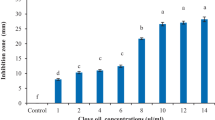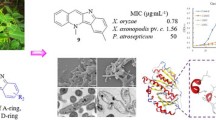Abstract
Bacterial leaf blight (BLB) disease, caused by Xanthomonas oryzae pv. oryzae (Xoo), causes major annual economic losses around the world. Inorganic copper compounds and antibiotics are conventionally used to control BLB disease. They often cause environmental pollution, contributing to adverse effects on human health. Therefore, research is now leading to the search for alternative control methods. Tea tree oil (TTO) is obtained from a traditional medicinal plant, Melaleuca alternifolia, with antibacterial properties. In this study, we found that TTO showed antibacterial activity against Xoo with a minimum inhibitory concentration (MIC) of 18 mg/ml. These antagonistic activities were not limited only to planktonic cells, as further studies have shown that TTO effectively eradicated sessile cells of Xoo in both initial and mature biofilms. Furthermore, it was also observed that TTO reduced various key virulence properties of Xoo, such as swimming, swarming motility, and the production of extracellular polymeric substances, xanthomonadin, and exoenzymes. TTO triggered ROS generation with cell membrane damage as an antibacterial mode of action against Xoo. The in silico study revealed that 1,8-cineole of TTO was effectively bound to two essential proteins, phosphoglucomutase and peptide deformylase, responsible for the synthesis of EPS and bacterial survival, respectively. These antibacterial and anti-virulence activities of TTO against Xoo were further confirmed by an ex vivo virulence assay where TTO significantly reduced the lesion length caused by Xoo on rice leaves. All these data concluded that TTO could be a safe, environment-friendly alternative approach for the comprehensive management of BLB disease.
Graphical abstract

Highlights
-
Tea tree oil (TTO) is effective against planktonic and sessile forms of Xanthomonas oryzae pv. oryzae (Xoo).
-
TTO shows antimotility activity and reduces EPS, xanthomonadin, and virulent exoenzyme production.
-
TTO damages the cell membrane and induces oxidative stresses as its mode of antibacterial action.
-
1,8-Cineole was found to be a potent compound, as it binds to peptide deformylase (PDF) and phosphohexose mutase (PHM).
-
In the ex vivo study, TTO also reduces the virulence properties of Xoo.






Similar content being viewed by others
Data availability
The data that support the findings of this study are available from the corresponding author upon reasonable request.
References
Banerjee S, Vishakha K, Das S et al (2020) Antibacterial, anti-biofilm activity and mechanism of action of pancreatin doped zinc oxide nanoparticles against methicillin resistant Staphylococcus aureus. Colloids Surf, B 190:110921. https://doi.org/10.1016/j.colsurfb.2020.110921
Bjarnsholt T, Ciofu O, Molin S et al (2013) Applying insights from biofilm biology to drug development — can a new approach be developed? Nat Rev Drug Discov 12:791–808. https://doi.org/10.1038/nrd4000
Bogino P, Oliva M, Sorroche F, Giordano W (2013) The role of bacterial biofilms and surface components in plant-bacterial associations. IJMS 14:15838–15859. https://doi.org/10.3390/ijms140815838
Brun P, Bernabè G, Filippini R, Piovan A (2019) In vitro antimicrobial activities of commercially available tea tree (Melaleuca alternifolia) essential oils. Curr Microbiol 76:108–116. https://doi.org/10.1007/s00284-018-1594-x
Carson CF, Hammer KA, Riley TV (2006) Melaleuca alternifolia (tea tree) oil: a review of antimicrobial and other medicinal properties. CMR 19:50–62. https://doi.org/10.1128/CMR.19.1.50-62.2006
Chukwu SC, Rafii MY, Ramlee SI et al (2019) Bacterial leaf blight resistance in rice: a review of conventional breeding to molecular approach. Mol Biol Rep 46:1519–1532. https://doi.org/10.1007/s11033-019-04584-2
Costerton JW (1999) Bacterial biofilms: a common cause of persistent infections. Science 284:1318–1322. https://doi.org/10.1126/science.284.5418.1318
Cox SD, Mann CM, Markham JL et al (2001) The mode of antimicrobial action of the essential oil of Melaleuca alternifolia (tea tree oil): S.D. COX ET AL. J Appl Microbiol 88:170–175. https://doi.org/10.1046/j.1365-2672.2000.00943.x
Das S, Vishakha K, Banerjee S et al (2020) Sodium alginate-based edible coating containing nanoemulsion of Citrus sinensis essential oil eradicates planktonic and sessile cells of food-borne pathogens and increased quality attributes of tomatoes. Int J Biol Macromol 162:1770–1779. https://doi.org/10.1016/j.ijbiomac.2020.08.086
AD ElmezayenA Al-Obaidi AT Şahin K Yelekçi 2020 Drug repurposing for coronavirus (COVID-19): in silico screening of known drugs against coronavirus 3CL hydrolase and protease enzymes J Biomol Struct Dyn 1–13 https://doi.org/10.1080/07391102.2020.1758791
Ganguli A, Choudhury D, Chakrabarti G (2014) 2,4-Dichlorophenoxyacetic acid induced toxicity in lung cells by disruption of the tubulin-microtubule network. Toxicol Res 3:118. https://doi.org/10.1039/c3tx50082a
Goel AK Rajagopal L Nagesh N Sonti RV 2002 Genetic locus encoding functions involved in biosynthesis and outer membrane localization of xanthomonadin in Xanthomonas oryzae pv. oryzae JB 184 3539 3548 https://doi.org/10.1128/JB.184.13.3539-3548.2002
Groppo FC, Ramacciato JC, Simões RP et al (2002) Antimicrobial activity of garlic, tea tree oil, and chlorhexidine against oral microorganisms. Int Dent J 52:433–437. https://doi.org/10.1111/j.1875-595X.2002.tb00638.x
Hu J, Qian W, He C (2007) The Xanthomonas oryzae pv. oryzae eglXoB endoglucanase gene is required for virulence to rice: Xoo eglXoB gene required for virulence to rice. FEMS Microbiol Lett 269:273–279. https://doi.org/10.1111/j.1574-6968.2007.00638.x
Hung C-H, Wu H-C, Tseng Y-H (2002) Mutation in the Xanthomonas campestris xanA gene required for synthesis of xanthan and lipopolysaccharide drastically reduces the efficiency of bacteriophage φL7 adsorption. Biochem Biophys Res Commun 291:338–343. https://doi.org/10.1006/bbrc.2002.6440
Jansson P, Kenne L, Lindberg B (1975) Structure of the extracellular polysaccharide from Xanthomonas campestris. Carbohyd Res 45:275–282. https://doi.org/10.1016/S0008-6215(00)85885-1
Jarrell KF, McBride MJ (2008) The surprisingly diverse ways that prokaryotes move. Nat Rev Microbiol 6:466–476. https://doi.org/10.1038/nrmicro1900
Jiang N, Yan J, Liang Y, et al. (2020) Resistance genes and their interactions with bacterial blight/leaf streak pathogens (Xanthomonas oryzae) in rice (Oryza sativa L.)—an Updated Review. Rice 13:3. https://doi.org/10.1186/s12284-019-0358-y
Khaledi N, Taheri P, Tarighi S (2015) Antifungal activity of various essential oils against Rhizoctonia solani and Macrophomina phaseolina as major bean pathogens. J Appl Microbiol 118:704–717. https://doi.org/10.1111/jam.12730
Kelley LA, Mezulis S, Yates CM et al (2015) The Phyre2 web portal for protein modeling, prediction and analysis. Nat Protoc 10:845–858. https://doi.org/10.1038/nprot.2015.053
Laskowski RA, Swindells MB (2011) LigPlot+: multiple ligand–protein interaction diagrams for drug discovery. J Chem Inf Model 51:2778–2786. https://doi.org/10.1021/ci200227u
Lee B-M (2005) The genome sequence of Xanthomonas oryzae pathovar oryzae KACC10331, the bacterial blight pathogen of rice. Nucleic Acids Res 33:577–586. https://doi.org/10.1093/nar/gki206
Li W-R, Li H-L, Shi Q-S et al (2017) Erratum to: the dynamics and mechanism of the antimicrobial activity of tea tree oil against bacteria and fungi. Appl Microbiol Biotechnol 101:2201–2201. https://doi.org/10.1007/s00253-017-8119-6
Mansfield J, Genin S, Magori S et al (2012) Top 10 plant pathogenic bacteria in molecular plant pathology: top 10 plant pathogenic bacteria. Mol Plant Pathol 13:614–629. https://doi.org/10.1111/j.1364-3703.2012.00804.x
Meena R, Kumar S, Datta R et al (2020) Impact of agrochemicals on soil microbiota and management: a review. Land 9:34. https://doi.org/10.3390/land9020034
Niño-Liu DO, Ronald PC, Bogdanove AJ (2006) Xanthomonas oryzae pathovars: model pathogens of a model crop. Mol Plant Pathol 7:303–324. https://doi.org/10.1111/j.1364-3703.2006.00344.x
Puvača N, Čabarkapa I, Petrović A et al (2019) Tea tree (Melaleuca alternifolia ) and its essential oil: antimicrobial, antioxidant and acaricidal effects in poultry production. Worlds Poult Sci J 75:235–246. https://doi.org/10.1017/S0043933919000229
Rajagopal L, Sundari CS, Balasubramanian D, Sonti RV (1997) The bacterial pigment xanthomonadin offers protection against photodamage. FEBS Lett 415:125–128. https://doi.org/10.1016/S0014-5793(97)01109-5
Raveau R, Fontaine J, Lounès-Hadj Sahraoui A (2020) Essential oils as potential alternative biocontrol products against plant pathogens and weeds: a review. Foods 9:365. https://doi.org/10.3390/foods9030365
Sahu SK, Zheng P, Yao N (2018) Niclosamide blocks rice leaf blight by inhibiting biofilm formation of Xanthomonas oryzae. Front Plant Sci 9:408. https://doi.org/10.3389/fpls.2018.00408
Shi C, Zhang X, Guo N (2018) The antimicrobial activities and action-mechanism of tea tree oil against food-borne bacteria in fresh cucumber juice. Microb Pathog 125:262–271. https://doi.org/10.1016/j.micpath.2018.09.036
Singh A, Gupta R, Tandon S, Pandey R (2017) Thyme oil reduces biofilm formation and impairs virulence of Xanthomonas oryzae. Front Microbiol 8:1074. https://doi.org/10.3389/fmicb.2017.01074
Singh A, Gupta R, Tandon S et al (2018) Anti-biofilm and anti-virulence potential of 3,7-dimethyloct-6-enal derived from Citrus hystrix against bacterial blight of rice caused by Xanthomonas oryzae pv. oryzae. Microb Pathog 115:264–271. https://doi.org/10.1016/j.micpath.2017.12.051
Sundin GW, Castiblanco LF, Yuan X et al (2016) Bacterial disease management: challenges, experience, innovation and future prospects: challenges in Bacterial Molecular Plant Pathology. Mol Plant Pathol 17:1506–1518. https://doi.org/10.1111/mpp.12436
Tian W, Chen C, Lei X et al (2018) CASTp 3.0: computed atlas of surface topography of proteins. Nucleic Acids Res 46:W363–W367. https://doi.org/10.1093/nar/gky473
O Trott AJ Olson 2009 AutoDockVina: improving the speed and accuracy of docking with a new scoring function, efficient optimization, and multithreading J Comput Chem NA-NA https://doi.org/10.1002/jcc.21334
Tago D, Andersson H, Treich N (2014) Pesticides and health: a review of evidence on health effects, valuation of risks, and benefit-cost analysis. In: Blomquist GC, Bolin K (eds) Advances in health economics and health services research. Emerald Group Publishing Limited, pp 203–295
Velásquez AC, Castroverde CDM, He SY (2018) Plant–pathogen warfare under changing climate conditions. Curr Biol 28:R619–R634. https://doi.org/10.1016/j.cub.2018.03.054
Vishakha K, Das S, Banerjee S, et al. (2020) Allelochemical catechol comprehensively impedes bacterial blight of rice caused by Xanthomonas oryzae pv. oryzae. Microbial Pathogenesis 149:104559. https://doi.org/10.1016/j.micpath.2020.104559
White FF, Yang B (2009) Host and pathogen factors controlling the rice-Xanthomonas oryzae Interaction. Plant Physiol 150:1677–1686. https://doi.org/10.1104/pp.109.139360
Xu J, Zhou L, Venturi V, et al. (2015) Phytohormone-mediated interkingdom signaling shapes the outcome of rice-Xanthomonas oryzae pv. oryzae interactions. BMC Plant Biol 15:10. https://doi.org/10.1186/s12870-014-0411-3
Xu Y, Zhu X-F, Zhou M-G, et al. (2010) Status of streptomycin resistance development in Xanthomonas oryzae pv. oryzae and Xanthomonas oryzae pv. oryzicola in China and their resistance characters. Journal of Phytopathology. https://doi.org/10.1111/j.1439-0434.2009.01657.x
Yuan Z, Trias J, White RJ (2001) Deformylase as a novel antibacterial target. Drug Discov Today 6:954–961. https://doi.org/10.1016/S1359-6446(01)01925-0
Acknowledgements
The authors are thankful to Chancellor, Techno India University, West Bengal for providing the necessary infrastructure and laboratory facilities. The authors are grateful to Dr. Bishun Deo Prasad (Bihar Agricultural University, Sabour, Bihar, India) for providing the Xanthomonas oryzae pv. oryzae (Xoo) strain. The authors are also thankful to Mrs. Sheolee Ghosh Chakraborty for supporting CLSM and Dr. Ritesh Tiwari for supporting flow cytometry facilities at Centre for Research in Nanoscience and Nanotechnology (CRNN), University of Calcutta, Kolkata, West Bengal.
Author information
Authors and Affiliations
Contributions
AG and KV designed the experiments; KV, SD, and SKD performed the experiments; AG, KV, and SD analyzed the data; AG and KV wrote the drafts of the article; AG supervised the manuscript. All authors revised and approved the final version of the manuscript.
Corresponding author
Ethics declarations
Ethics approval
Not applicable.
Consent to participate
Not applicable.
Consent for publication
Not applicable.
Conflict of interest
The authors declare no competing interests.
Additional information
Publisher's note
Springer Nature remains neutral with regard to jurisdictional claims in published maps and institutional affiliations.
Responsible Editor: Fernando R. Pavan
Rights and permissions
About this article
Cite this article
Vishakha, K., Das, S., Das, S.K. et al. Antibacterial, anti-biofilm, and anti-virulence potential of tea tree oil against leaf blight pathogen Xanthomonas oryzae pv. oryzae instigates disease suppression. Braz J Microbiol 53, 19–32 (2022). https://doi.org/10.1007/s42770-021-00657-2
Received:
Accepted:
Published:
Issue Date:
DOI: https://doi.org/10.1007/s42770-021-00657-2




